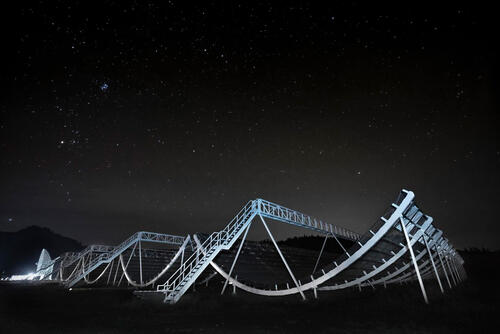
The Canadian Hydrogen Intensity Mapping Experiment ( CHIME) has reached “a milestone in the quest to discover the hidden origins of universal structure,” according to an article in Scientific American, called “Canadian Telescope Delivers Deepest-Ever Radio View of Cosmic Web,” written by Wright Lab alum Ben Brubaker (Yale Physics Ph.D. ‘17).
Laura Newburgh, assistant professor of physics and a member of Yale’s Wright Lab, has been involved with CHIME since she began working on novel methods of calibration for CHIME as a postdoctoral fellow at the University of Toronto. Currently, the Newburgh group measures the “beam” of the CHIME telescope–its response on the sky–in multiple ways, including flying radio sources on quadcopter drones, and using an old radio technique called holography. The beam must be measured extremely precisely to be able to make high-fidelity maps of the sky to extract the cosmological signal.
The scientific goal for the Newburgh group on CHIME is to better understand the nature of Dark Energy, a mysterious component that makes up ~72% of the energy density of the Universe, by measuring the expansion rate of the Universe far into the past.
The recent CHIME result, as explained in the article by Brubaker, verifies the ability of the CHIME experiment to detect the 21cm signature of neutral hydrogen in galaxies that will allow the Newburgh group to make measurements of the distribution of galaxies farther back in the past than before, which will tell them about the expansion rate of the Universe at a critical era when Dark Energy began impacting the expansion result. Furthermore, these measurements are made possible, in part, due to the precise calibrations of the telescope made by the efforts of Newburgh’s group.
CHIME is a set of 4 cylindrical dishes, each 100m long x 20m wide, located in British Columbia, Canada. It operates at 400-800MHz, to provide measurements of structure at redshifts z=0.8-2.5. The sky signal is focused onto a feed line at the focus of the cylinders, and detected by 1024 dishes connected to the largest correlator in radio astronomy. The CHIME project is co-led by the University of British Columbia, McGill University, the University of Toronto, and is hosted at the Dominion Radio Astrophysical Observatory by the National Research Council of Canada, with collaborating institutions across North America.
For more information on the recent CHIME result, please read the full Scientific American article, linked below.

